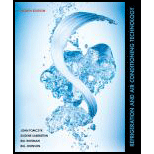
Refrigeration and Air Conditioning Technology (MindTap Course List)
8th Edition
ISBN: 9781305578296
Author: John Tomczyk, Eugene Silberstein, Bill Whitman, Bill Johnson
Publisher: Cengage Learning
expand_more
expand_more
format_list_bulleted
Concept explainers
Textbook Question
Chapter 42, Problem 11RQ
If a wall is made up of four different materials, all layered one on top of the other, how will the total R-value of the wall be determined?
A. By the one material with the highest R-value
B. By the one material with the lowest R-value
C. By averaging the R-values of the materials
D. By adding the R-values of the materials together
Expert Solution & Answer
Trending nowThis is a popular solution!

Students have asked these similar questions
Only question 3
Only question 2
Solve for the support reactions at A and B.
C
3 kN/m
B
-1.5 m-
-1.5 m 1.5 m-
1.5 m-
Chapter 42 Solutions
Refrigeration and Air Conditioning Technology (MindTap Course List)
Ch. 42 - An oversized air-conditioning system will A. cost...Ch. 42 - Methods used to calculate the heat gain and heat...Ch. 42 - An exterior wall A. separates a conditioned...Ch. 42 - A partition wall A. separates a conditioned...Ch. 42 - As the temperature differential across a panel...Ch. 42 - The typical indoor design temperature used for...Ch. 42 - The typical indoor design temperature used for...Ch. 42 - If a heating system was being designed for use in...Ch. 42 - If an air-conditioning system was being designed...Ch. 42 - If the R-value of a construction material is 2.0,...
Ch. 42 - If a wall is made up of four different materials,...Ch. 42 - Prob. 12RQCh. 42 - All of the following are taken into account on a...Ch. 42 - How much heat is lost through a 3' 5' single-pane...Ch. 42 - Which of the following is(are) true regarding a...Ch. 42 - Which of the following is(are) true regarding the...
Knowledge Booster
Learn more about
Need a deep-dive on the concept behind this application? Look no further. Learn more about this topic, mechanical-engineering and related others by exploring similar questions and additional content below.Similar questions
- 4. Solve for the support reactions at A and B. W1 600 lb/ft W2 150 lb/ft A Barrow_forwardIn cold isostatic pressing, the mold is most typically made of which one of the following: thermosetting polymer tool steel sheet metal textile rubberarrow_forwardThe coefficient of friction between the part and the tool in cold working tends to be: lower higher no different relative to its value in hot workingarrow_forward
- The force F={25i−45j+15k}F={25i−45j+15k} lblb acts at the end A of the pipe assembly shown in (Figure 1). Determine the magnitude of the component F1 which acts along the member AB. Determine the magnitude of the component F2 which acts perpendicular to the AB.arrow_forwardHi can you please help me with the attached question?arrow_forwardHi can you please help me with the attached question?arrow_forward
arrow_back_ios
SEE MORE QUESTIONS
arrow_forward_ios
Recommended textbooks for you
 Refrigeration and Air Conditioning Technology (Mi...Mechanical EngineeringISBN:9781305578296Author:John Tomczyk, Eugene Silberstein, Bill Whitman, Bill JohnsonPublisher:Cengage Learning
Refrigeration and Air Conditioning Technology (Mi...Mechanical EngineeringISBN:9781305578296Author:John Tomczyk, Eugene Silberstein, Bill Whitman, Bill JohnsonPublisher:Cengage Learning Principles of Heat Transfer (Activate Learning wi...Mechanical EngineeringISBN:9781305387102Author:Kreith, Frank; Manglik, Raj M.Publisher:Cengage Learning
Principles of Heat Transfer (Activate Learning wi...Mechanical EngineeringISBN:9781305387102Author:Kreith, Frank; Manglik, Raj M.Publisher:Cengage Learning

Refrigeration and Air Conditioning Technology (Mi...
Mechanical Engineering
ISBN:9781305578296
Author:John Tomczyk, Eugene Silberstein, Bill Whitman, Bill Johnson
Publisher:Cengage Learning

Principles of Heat Transfer (Activate Learning wi...
Mechanical Engineering
ISBN:9781305387102
Author:Kreith, Frank; Manglik, Raj M.
Publisher:Cengage Learning
Understanding Conduction and the Heat Equation; Author: The Efficient Engineer;https://www.youtube.com/watch?v=6jQsLAqrZGQ;License: Standard youtube license